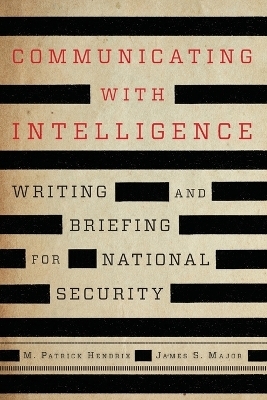
Communicating with Intelligence
Rowman & Littlefield (Verlag)
978-1-5381-6067-1 (ISBN)
Writing and briefing are fundamental to the intelligence profession. The ability to communicate clearly, concisely, and coherently is basic to all intelligence disciplines, even the most technical. Communicating with Intelligence, Third Edition is a handbook on writing and briefing intelligence based on the decades of practical experience of James S. Major. The book is designed primarily for faculty and students pursuing studies in intelligence, national security, and homeland security, who need to learn the art of preparing written products and intelligence briefings. But it also has considerable value for working professionals who simply wish to sharpen their communication skills. The third edition of Communicating with Intelligence provides the expediency, efficiency, and effectiveness instructors and members of the Intelligence Community require for a communication handbook.
M. Patrick Hendrix is an assistant professor in the Department of Intelligence and Security Studies at The Citadel Military College of South Carolina. He teaches a variety of undergraduate and graduate courses including open-source intelligence, analysis and research, and Geospatial intelligence. He previously served as director of The Citadel’s Writing Center. James S. Major spent 40 years in intelligence, serving in both military and civilian capacity, in assignments at the tactical, operational, strategic, and national levels. He has previously written 15 books, all published by the U.S. Government, and in 1997 he was awarded the National Intelligence Medal of Achievement.
Preface
Introduction – Jan Goldman
Part I: The Foundations of Good Intelligence Communication
What It's All About
Bottom Line Up Front Analysts: The Voice of the Intelligence Community
Getting Started:
Consider the Reader
The Style of Good Intelligence Writing: Bottom Line Upfront
Three Goals of Intelligence Writing: Judge, Interpret, Support
Real World Problems
Four differences Between Academic and Intelligence Writing
Making the Distinction Clear – Especially for Students
Facilitating the Process
Final Thoughts and Exercises
Notes
Using Argument in Intelligence Writing
Bottom Line Up Front
What is an Argument?
Formulating a Thesis Statement
Argument Reflects How Humans Think
Evaluating Arguments
Final Thoughts and Exercises
Reading: Fundamental to Writing
Bottom Line Up Front
Read to Write
The Forms of Intelligence: Basic, Current, Estimative
Examining Content
Evaluating Finished Intelligence
Graphics: Attention Grabbers
Final Thoughts and Exercises
Part II: Writing with Intelligence
Research Methods
Bottom Line Up Front
Time Management
Searching, Researching
Evaluating Sources
Final Thoughts and Exercises
Analysis Check
Bottom Line Up Front
Structured Analytic Techniques
Final Thoughts and Exercises
Prewriting
Bottom Line Up Front
Finding Your Subject
Focusing on Form and Format
Finding Time and Managing Length
Prewriting Tools: Building a Foundation
Final Thoughts and Exercises
Writing the First Draft
Bottom Line Up Front
Drafting: Get Right To It
Set Realistic Goals and Pace Yourself
Clarity: Be Kind to Your Reader
Time to Get Organized
Transitions: Moving Smoothly Ahead
Introductions: Not Methodology
The Body of Your Writing
Drafting Conclusion: The Role of Intelligence Writing
Final Thoughts and Exercises
Finishing a Draft
Bottom Line Up Front
A Model Process for Revising an Analytical Paper
Constraints on Review
Reviewer and Writer’s Experience
Basic Revision Techniques
Thesis and Overview Statements
Commonly Asked Questions about Revision
Ten Questions to Help You Examine Your Own Writing Process
Exercises in Writing Analytical Papers
Part III: Briefing with Intelligence
Scripting Your Briefing
Bottom Line Up Front
A Disclaimer: Read and Heed
A Brief Typology of Briefings
The Organization, Mission, and Functions Briefing
The ABCs of Good Intelligence Briefings and Briefers
Get Started: Get Organized
Prewrite
Analyze Your Audience
Outline Your Thoughts
Writing the Script
Pointers for Writing the Script
Use of Notes
Using Visual Aids
Putting Words and Pictures Together
Final Thoughts and Exercises
Briefing the Customer
Bottom Line Up Front
Appearance: Make First Impressions Count
Cognizance: Knowledge Really Is Power
Final Thoughts and Exercises
Citing Your Sources
Handling and Citing Classified Material
Appendix A: Memo for the Director and Deputy Director from Vice Chairman of the National Intelligence Council Herbert E. Meyer
Appendix B: FBI Intelligence Estimate
Appendix C: Briefing Evaluation Form
Bibliography
Dictionaries and Thesauruses
Sources for Writing Style, Grammar, and Composition
Sources for Analysis and Research
Briefing-Related Sources
Other Sources Used or Consulted for This Book
About the author
Index
| Erscheinungsdatum | 26.10.2022 |
|---|---|
| Reihe/Serie | Security and Professional Intelligence Education Series |
| Verlagsort | Lanham, MD |
| Sprache | englisch |
| Maße | 151 x 229 mm |
| Gewicht | 458 g |
| Themenwelt | Sozialwissenschaften ► Kommunikation / Medien ► Kommunikationswissenschaft |
| Sozialwissenschaften ► Politik / Verwaltung ► Staat / Verwaltung | |
| ISBN-10 | 1-5381-6067-6 / 1538160676 |
| ISBN-13 | 978-1-5381-6067-1 / 9781538160671 |
| Zustand | Neuware |
| Informationen gemäß Produktsicherheitsverordnung (GPSR) | |
| Haben Sie eine Frage zum Produkt? |
aus dem Bereich


